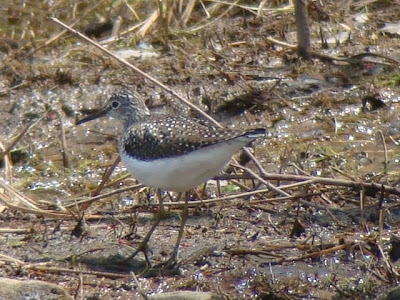It was an incredibly nice day out there today so I just couldn't resist doing some birding on the way home. The first stop was 5-Rivers.

They manage the fields at 5-Rivers by mowing them at set intervals. This seems to work out well for the Bobolinks. A female is pictured above.

One of the fields has some small saplings in it and Prairie Warblers can be found there. This bird actually looks to have a band on it's right leg. They do research at 5-Rivers and perhaps this bird is part of it.

Pine Warblers have also returned. This guy just wouldn't stop singing.

This was a nice opportunity to get a look at one. Once they set up territory and start nesting, they spend most of their time high up in the pines.

After I left 5-Rivers, I stopped at the Bennett Hill Preserve in Clarksville. I wanted to see if an old friend had arrived yet. I walked up the trail and as I neared the spot that I wanted to check, a bird flew low across the trail. This Hooded Warbler has been at the preserve for the past 3 years. It didn't look quite right and was acting much different than it had in the past. The bird was silent and that was strange since it usually sang constantly. The fact that a bird like this can find it's way to wintering grounds some 3000 miles away and then find it's way back to the same small patch of woods is incredible. I've read a lot of attempts to explain how birds navigate during migration and never really found any that convince me 100%. I think it's one of those mysteries that mother nature still has not revealed. Welcome back old friend!.... and how the heck did you do it?


.JPG)
.JPG)



















